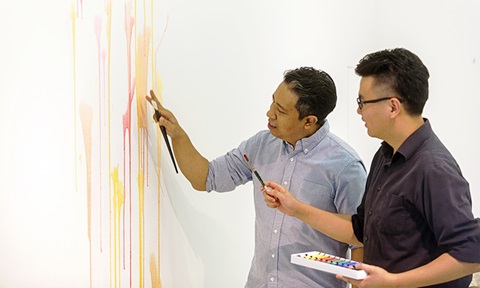Sensory play: Rise in demand for fun, messy child-led activities
SINGAPORE – Whether it is toddlers pouring sand created from cereal or pre-schoolers scooping pretend frogspawn made from chia seeds, sensory play is having a moment.
Programmes focused on sensory play, or activities that engage a child’s senses, are seeing a boom in demand, with several new businesses setting up in recent years.
These open-ended and child-led activities, which involve multiple sensory play stations, often take place at East Coast Park, the Botanic Gardens and other outdoor spaces.
The latest activities, typically catering to babies and young children, sometimes involve elaborate dioramas with items like pine cones, toy figurines, flowers, fruits, fabrics, musical instruments and kitchen utensils.
It is a far cry from traditional stereotypes of a two-year-old playing with a sensory tray filled with uncooked rice and dried pasta.
Food-grade, handmade and child-safe materials are de rigueur. Oobleck, a fascinating suspension of corn starch and water that behaves like a liquid while at rest and like a solid when pressure is applied, is ubiquitous.
Vendors, some of whom have pre-school teaching experience, report that some customers ask for entire birthday parties for their child centred on sensory play. Prices for a two-hour session can start at around $30 a child, while a birthday party can cost up to $600.
Sensory play has a host of benefits such as contributing to children’s holistic development, and enhancing their fine and gross motor skills and cognitive abilities. While the rising demand is being driven by greater awareness of the value of play, observers caution that not all children take to sensory play.
Dr Geraldine Teo-Zuzarte, a Fellow at the Early Childhood Development Agency (ECDA), which oversees the early childhood sector in Singapore, says: “Sensory play is not new, but it has become the flavour of the month.”
ECDA Fellows like her are recognised by the agency as exemplary early childhood professionals.
Dr Hanin Hussain, who specialises in early childhood education at National Institute of Education (NIE), Nanyang Technological University Singapore, says: “Since many children attend pre-school, their parents may already be familiar with the child’s sensory play experiences there.
“At the same time, I also wonder why parents are paying for such sensory play experiences when these can be facilitated at home, in the neighbourhood or outdoors, for free or at low cost.”
Little worlds
Ms Joymarie Soo is the 30-year-old founder of Little Blue Chair, a business that focuses on sensory play. She and her engineer mother, 53, create intricate sensory play sessions, usually with storytelling thrown in.
One recent Sunday, about 20 little ones, accompanied by their parents, participated in a sensory play session at Marine Cove at East Coast Park. Based on the theme of adventure across the world, the “London” sensory play station had items such as an iconic London toy bus, Paddington Bear, a teapot, water, chickpeas, black beans and train tracks.
The “Italy” play area included a cardboard pizza oven, flowers, a rolling pin, pots, homemade playdough and the children’s book, Olivia Goes To Venice.
“We create these elaborate set-ups because they help spark the imagination. It’s a lot more engagement. Putting beans in a bottle (for sensory play) would not have the same effect,” says Ms Soo. Her husband runs a tuition agency and their sons are aged one and three.
She adds: “We want our children to get dirty, get messy, meet people, learn how to resolve conflicts and solve problems. More programmes are shifting towards slower, meaningful play and being in nature.”
She uses “taste-safe ingredients” in messy play. She makes “slime” using chia seeds, and paint from yogurt, coloured with red beetroot powder or green spinach powder. The sand is made from ground oats or ground Cheerios, a brand of cereal.
Since Ms Soo launched Little Blue Chair in June 2024 with two sessions that month, the response has been “huge, unexpected”, she says. A month later, in July 2024, she staged four sensory play events and already had a waitlist.
Now, she holds sessions a few days a week, works with pre-schools and organises sensory play birthday parties.
A 1½-hour session by Little Blue Chair costs $45 a child, while a birthday party for 12 children is priced at $600. The youngest participant at its sensory play events was four months old, while the oldest was nine years old.
Boosted by parenting culture
At enrichment provider Little Joy Play, which offers sensory play programmes, the uptick in demand has been fuelled by societal awareness and parenting culture.
Inquiries have increased by 30 per cent and enrolment in sensory play programmes has risen by about 20 per cent since October 2024, says co-founder Meyi Ongsono, 34.
Since Little Joy Play opened its doors in April 2023 in Upper Bukit Timah, it has expanded to a second outlet in Pasir Ris. The company also conducts sensory play sessions at indoor playgrounds. It started a new sensory play programme conducted in Mandarin in 2024.
Little Joy Play charges $180 monthly for four sessions of sensory play lasting one hour each. Private play dates can be arranged for $55 a child, while sensory play birthday parties start at $280 for five children.
Ms Meyi and her co-founder, Ms Indri Huang, 33, used to work as pre-school teachers.
Ms Meyi says the immersive, hands-on exploratory play at Little Joy Play would have been “tough to conduct in a pre-school setting”.
She adds: “At pre-school, it’s rushed, with higher teacher-children ratios (compared with us), and space constraints.”
Ms Indri acknowledges the impact of wider trends such as increasingly sensorial playgrounds – some with features like water play – and parental interest in baby-led weaning, an approach to introducing solids that bypasses purees and allows babies to self-feed using their fingers.
She says: “The children are exposed to different textures and baby-led weaning is messy play in itself, and could reduce food neophobia.” This is a rejection of or reluctance to try new and different foods.
Dr Hanin concurs that kids with food neophobia or picky eaters can benefit from such play.
“Sensory play involving food textures and smells has been shown to increase children’s willingness to try unfamiliar fruits and vegetables.
“This can help to effectively reduce aversions to certain foods and encourage children to eat a variety of foods, which is important for health and well-being,” says Dr Hanin, a senior lecturer in psychology and child and human development at NIE.
She adds that, besides neurotypical children, other groups of youngsters who benefit from sensory play include sensitive or anxious children. “Sensory play can help children self-regulate and reduce stress since it can have a soothing or calming effect,” she says.
How much stimulation is enough?
Despite its many benefits, there are caveats to sensory play.
Dr Teo-Zuzarte says that “sensory overload” is possible, with children getting overly stimulated, and urges facilitators to consider the age, preferences and developmental stage of the child. An infant, for instance, need not be introduced to too many textures during play.
She adds: “Sensory play has to be child-led. This allows children to be given choices to explore, in their own way, a variety of materials.”
Dr Hanin says: “Children with sensory sensitivities or sensory processing disorders may become overwhelmed by certain textures, sounds or lights used in sensory play. This can lead to anxiety, meltdowns or avoidance behaviours.”
The downside to messy play
Ms Syafiqah Yusry, 30, founder of Pastel Senses, which provides sensory play activities, says there are practical reasons parents may choose to pay for such experiences for their children.
The pre-school teacher says: “My intention for starting this is linked to how parents are sometimes too afraid to let their children play. They want their children to be messy, but they don’t want to clean up. I believe in reframing mess as a way for children to explore.”
She started Pastel Senses, her “passion project”, in September 2023 and has seen growing demand for her sensory play activities and birthday parties. A two-hour session costs between $28 and $35, while a birthday party can cost $350 for 10 guests.
Stay-home mum Dayana Noor Mohamed, 34, has engaged Pastel Senses for her four-year-old daughter, Inaaya Muhammad Daniaal, and two-year-old son, Noah Muhammad Daniaal. Inaaya recently had a birthday party curated by Ms Syafiqah.
Ms Dayana finds value in sensory play sessions in allowing children freedom from a routine filled with instructions about what to do and when.
She says: “This is the kids’ time to decide what to do and how to play. It feels empowering to them. They’re a lot calmer and happier after classes like this.”
Another parent, arts producer Carol Chen, has been taking her 17-month-old daughter Phoebe Chan for sensory play sessions conducted by The Playmakers, whose founder Ruby Topas, 53, has seen increased inquiries and engagements.
Ms Chen, 40, appreciates how her toddler likes to play with “loose parts” while practising her motor skills – by scooping and transferring beads, chickpeas or small cubes – rather than playing with a dollhouse or toy phone.
She says: “At home, she doesn’t have such a variety and combination of materials. I enjoy seeing her grow.
“When she first went, she didn’t enjoy the playdough, which was made with flour. Eventually, she took a button and pressed it into the dough. I like that she has a sense of curiosity and openness. She’s trying more things and is not afraid of things she doesn’t know or hasn’t mastered.”
She adds: “Phoebe may not have exact memories of this time, but I hope the takeaway for her is that she had fun during her childhood.”
Read the original article here.
Source: The Straits Times © SPH Media Limited. Permission required for reproduction.



.tmb-listing.jpg?Culture=en&sfvrsn=39c6b3f_1)


